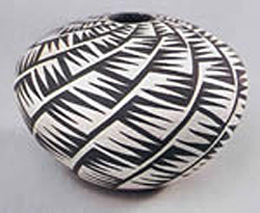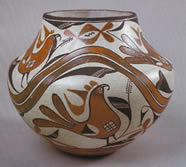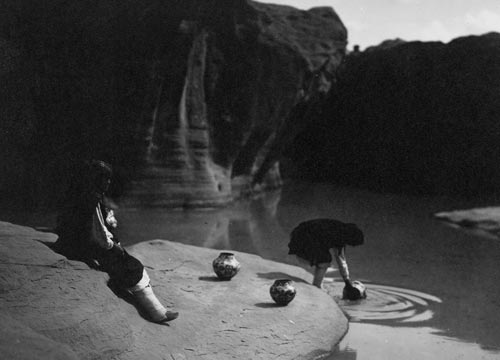




Taos Art School
LUCY LEWIS TRADITIONAL POTTERY MAKING |
Claudia (Lewis) Mitchell
Grand daughter
of Lucy Lewis
Featured in New Mexico Magazine!
Beginning to Advanced
Class,
limited to 15 participants
Feel free to Call us for more Information
about this wonderful workshop.
We love to chat about our classes. 575-758-0350

Green Corn Dance mural by Pablita Velarde |
|
|
We consider
our pots
to have a life of their own."
~ Lucy Lewis |
|
|
|
Lucy
Lewis is regarded as the matriarch of Acoma pottery and
alongside Maria Martinez, is one of the best known Southwestern
potters. She started making pottery around the turn of
the century, continuing a tradition dating back hundreds,
if not thousands of years. |
We are extraordinarily privileged to have
Lucy's granddaughter
lead us in this workshop. She is dedicated
to using the authentic processes and techniques that have
been traditional to Acoma potters for centuries. She
will lead us through each of the time honored steps necessary
to the creation of authentic Acoma pottery. After demonstrating
their methods, she will give us a lot of personal attention
as we prepare the clay, tools, and paints, and then begin
our traditional pottery making experience.
This experience
is dedicated to the authentic processes and techniques
that have been traditional to Puebloan Potters for Centuries.
You will be led through each time-honored step necessary
to create authentic pottery. Along the way we will share
stories of the Ancestors, for these experiences are as
much about Culture as they are about Clay. In these classes,
you will:
• Work with Native Clay Bodies, dug by your teacher from the same clay pits used by Lucy Lewis.
• Hand form 2 small pots with the coil/slab method which are
then highly burnished with a smooth river stone and slipped with white kaolin.
• Create your very own ‘yucca brush’ from the rib of the Yucca plant, about 4 " long, with one end chewed to form a brush. This sounds primitive, but it is actually the most efficient way to paint a straight line on a curved surface.
Back to Top |
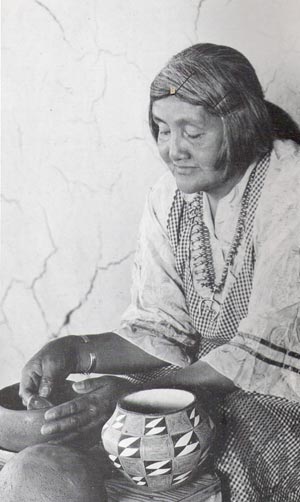
Lucy Lewis, ca. 1950
• Paint Traditional designs on your pots, using both mineral and vegetal paints you will learn to grind by hand, using a Metate.
• Fire your pots, with traditional open-pit firing demonstration, using either cow-dung or wood chips.
• Participants in this class will take home some fine, small examples of this magnificent pottery, made with our own hands.
View a National Geographic Article:
Pueblo Pottery, 1982
|
|
~~~~~~~~~~~~~~
Article from a section entitled BE THE MAKER
on page 44 of the January 2016 New Mexico Magazine
Go to the Source
Along with Maria Martinez of San Ildefonso Pueblo, Lucy Lewis of Acoma Pueblo is regarded as one of the most famous and skilled Southwest potters. Today, her granddaughter Claudia Lewis Mitchell is the standard-bearer of the family’s traditions—not only in craftsmanship, but also in teaching. Lucy taught workshops at Taos Art School, then passed the mantle to her daughter, and now to Claudia, who leads attendees through steps her family has followed for generations.
The workshop begins in Taos, when each participant is given a small share of clay Claudia has dug out of the earth. The next few days, they learn to form, burnish and slip, and paint their pottery with a brush chewed from the rib of a yucca plant. The final evening of the workshop, the group journeys southwest to Acoma Pueblo, standing in the spot where Lucy once sat to form her pots, and feasting with the Lewis family in their traditional home on the mesa top. The last morning of the class, the pots are fired in shallow pits at Acoma. “It’s a truly authentic experience of not only the way they make pots, but why they do,” says Taos Art School director Ursula Beck. .... Taos Art School, Taos; (575) 758-0350; taosartschool.org
~~~~~~~~~~~~~~ |
|

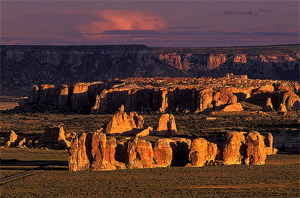
Acoma - Sky City
|
SPECIAL
FEATURES!
Because this is an experience as much about Culture as it is about Art-making, we have arranged three additional events offering immersion for you.
|
 |
Thursday: on the 5th day, participants have the option, on their own, of attending the Traditional Corn Dance and Feast of San Lorenzo at Santo Domingo Pueblo. This centuries old event, honoring the Corn Mother who feeds us all, features beautiful, costumed dancers, their feet bared for direct contact with Mother Earth.
|
 |
Friday, 3:30 PM An optional group tour - You may enjoy a group tour of the breathtaking Acoma Pueblo known as Sky City. (This is self-pay) Acoma is the oldest continuously inhabited city in the United States. Please check out this beautiful site - and don't miss it!
|
 |
Friday 6 PM The Lewis clan will prepare and join us for a traditional feast.
Acoma Pueblo is located approx 200 miles SW of Taos.
|
|
Note: Friends and family members of class participants, who are not attending the workshop, are welcome to join us for these events for a small additional fee. Advanced registrations is essential. Please call the office to arrange.
Back to Top |
|
|
|
CLASS SCHEDULE FOR LUCY LEWIS POTTERY WORKSHOP © 2016 |
Sat |
Sun |
Mon |
Tues |
Wed |
Thurs |
Fri |
Sat |
2 - 5 PM
Check in
to lodging
5:30 - 6:30
Reception
|
9 AM
class starts
Form
1st
Pot
|
|
|
Finish
Pots
Pots are overnight
in Kiln
|
Optional
Santo Domingo Pueblo*
CORN
DANCE
Pots continue drying in kiln
|
AM
Pick up
dry pots
Drive to
Acoma
Evening
Traditional Feast
|
AM
Firing
Class ends
Depart
|
NOTES ON SCHEDULE
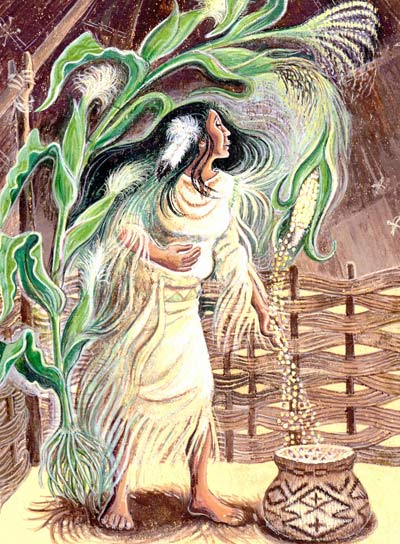
Class times: Class will be from 9-4 each day with a lunch break to go to one of several nearby restaurants. Students also have the option to bring a snack/lunch to eat in the clay studio.
Thursday: You have the option of attending the Traditional Corn Dance of San Lorenzo at Santo Domingo Pueblo, 25 miles south of Taos. This is not an official part of the class experience, but we highly recommend that you plan to attend, since you will be in the area, and this is not to be missed.
This centuries old event, honoring the Corn Mother who feeds us all, features beautiful, costumed dancers, their feet bared for direct contact with Mother Earth. This event will be seen continuously from 10 AM – around 3 PM since there are 2 Pueblo groups which alternate: Turquoise Group & Pumpkin Group. There are many booths with traditional food for sale, as well as art & craft items to purchase. Because Santo Domingo Pueblo is located near the ancient Cerrillos turquoise mines, the village people have a distinguished history of making fine jewelry and heishi. The Santo Domingo people are still great traders, very much like their Mesa Verde and Chaco Canyon ancestors. Many roadside stands with jewelry, pottery and silverwork for sale can be found during a visit to this pueblo. Look for these special items and others during the Festivals. NOTE: Photography is not permitted at this sacred event. Also, Both Men & Women are requested not to wear shorts. Bring a Hat.
You will be largely on your own this day, driving to the Pueblo in your own car or sharing with a fellow participant. Some only wish to stay for the morning ceremonies while others may choose to remain for the entire day of Ceremonies and Shopping.
Click here for an article about the Corn Dance: A Timeless Pueblo Ritual
Click here for images of the Corn Dance: Corn Dance Images
You will return to your Taos lodging after your day at the Corn dance. If you leave Taos early in the morning to attend the morning ceremonies in Santa Domingo, there will be time for some afternoon shopping in Taos upon your afternoon return. Friday morning early you will pick up your pots in Taos in preparation for the drive to Acoma.
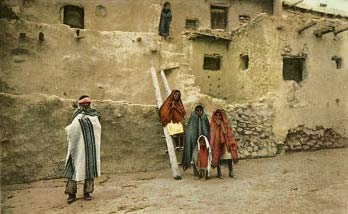 Friday: We pick up our dry pots early and then students drive individually in their own cars to Acoma Pueblo, 5-6 hours SW of Taos. We meet for an optional tour of the Village of Acoma, then check into your hotel.
We re-group for the Traditional Feast in the evening.
Saturday: We gather once again for the Early morning Firing Demonstration. We should be finished by
11-noon, depending on the vagaries of the weather.
Reception: The opening reception will be held at the Kachina Lodge Saturday 5:30-6:30 PM.Your teachers will be in attendance, dressed in Traditional Dress, and introductions will be made. Family members and friends traveling with students are welcome to attend. Afterward, students may break up into groups, or travel as individuals to several nearby restaurants. There is a full service restaurant in the hotel for those who have had enough travel for one day! This is not mandatory, but if you are coming to Taos we want you to feel welcome and we will be available to pass out maps and answer any questions.
Drive Times:
The Santo Domingo Pueblo is located 25 miles south of Santa Fe, off I-25 at the Santo Domingo exit. The drive is approximately 2 hours South of Taos, and, one half an hour SW of Santa Fe.
Drive time from Acoma Pueblo to the Albuquerque Airport is approx. 3-4 hours S/E.
Map from Taos to Santo Domingo Pueblo | Map from Taos to Acoma Pueblo
Acoma Pueblo - "Sky City" | More about Acoma at Wikipedia
Santo Domingo Pueblo | More about Santo Domingo at Wikipedia
Back to Top |
|
Learn More
About Lucy Lewis |
AMERICAN INDIAN POTTER
Lucy M. Lewis
by Susan Peterson
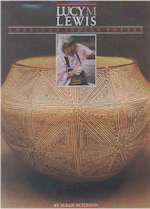
The Acoma pueblo is the oldest continuously inhabited settlement
in North America. This Indian community, which probably dates
back over a millennium, was home to one of America's most talented
and innovative potters-Lucy M Lewis (d. 1992). Born around the
turn of the century, Lewis rose from humble origins to become
one of the most important craftsperson's of this century. As
mother, matriarch, and artist, she created a monumental statement
of her society. She absorbed the work of her Indian ancestors,
and from their ancient designs fashioned a modern sensibility
that brought Indian pottery into the twentieth century.
She began making pots at an early age, teaching herself from
shards she had found around her home. With age, practice, and
a keen eye came perfection, and eventually admirers. Her pieces
are now in the collections of prominent museums in New York,
Washington, D.C., and Los Angeles, as well as throughout the
Southwest.
Susan Peterson's intimate biography is a major accomplishment.
It captures the essence of this inspirational women with candor
and affection. Over 220 color plates (and 120 black-and-white
photos) convey the life and work of Lucy and her family. Lucy
M. Lewis: American Indian Potter not only offers insights into
the sources and milieu of Lewis' vast talent, but documents
the achievements of one of America's greatest native craftswomen.
For Further Reading about
The Lucy Lewis Family:
- Generations in Clay: Pueblo Pottery of the American Southwest,
by Alfred E. Dittert, Jr., Fred Plog
- ACOMA: Pueblo in the Sky, by Ward Alan Minge
- Acoma & Laguna Pottery, by Rick Dillingham
- ACOMA: People of the White Rock, by H.L. James
- Women Artists: Works from the National Museum of Women
in the Arts
|
Daughters of the Anasazi:
Lucy Lewis, Emma Lewis Mitchell, Delores Lewis Garcia
Produced and Directed by John Anthony
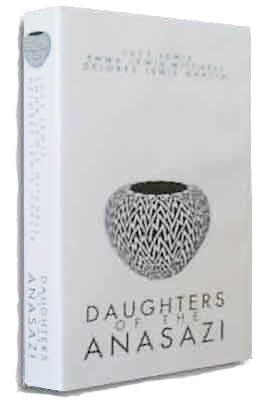
Length: 28 minutes.VHS tape available used on Amazon.com. Or you can get the DVD at http://www.axner.com/daughters-of-the-anasazi-dvd.aspx
More and more I find myself drawn to ceramic videos dealing with historical subjects or traditional ways of working. This well-produced video is one of those, focusing on the work of Lucy Lewis and her daughters Emma Lewis Mitchell and Delores Lewis Garcia, Acoma pueblo potters. As they carry on the pottery traditions of the Anasazi Indians, who inhabited the Chaco Canyon region of New Mexico until 1300 AD, we see the painstaking production of their ceramic vessels and hear the rationale for their methods.
Clay is dug from the hills, carried home, and stone ground by hand. Centuries-old Anasazi pot shards are pounded to bits for grog, literally incorporating the old into the new. Pinch and coil methods are used for construction; everything is slipped and burnished preparatory to painting, and then the pots are decorated.
Paints are produced from hand-selected and ground rocks, mixed with water and a binder made of wild spinach juice and the Rocky Mountain bee plant. Brushes come from the yucca plant (well chewed for added
softness). These traditional methods of production give the pots their spirit, it is said. The painting is elaborate, intricate and beautiful, using symbols referring to "Mother Nature", and designs both traditional and individual. Then the pots are fired in cow dung, cleaned, and sold. It's like "giving away one's babies," we are told by one of the artists.
A very interesting film recommended for both potters and non-potters.
Reviewed by Richard Aerni. Studio Potter Network Newsletter, Autumn, 1992.
Back to Top |
|
|
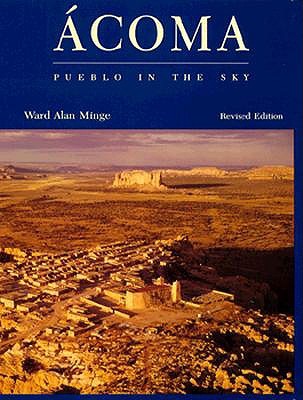
|
Book: The only official history of the Sky City sanctioned by the tribal council, Acoma: Pueblo in the Sky (1991) by Ward Alan Minge chronicles the social, economic, and political history of the Acoma tribe. For centuries the people of Acoma have endured newcomers on the New Mexican plains who often came at once to marvel at, and manipulate, the Acoma way of life. Through the advent of rival tribes, the Spanish, and the thousands of tourists who now visit Sky City every year, the Acomas have weathered years of such intrusions.
Drawing on tribal documents, Minge traces the evolution of the pueblo and explores the ongoing struggle of the Acomas to preserve their traditions. He pays particular attention to the problems that beset the nation during the twentieth century and demonstrates how, through their successful efforts to regain lost lands, the development of their economy, and the creation of their own social-service programs, they have persevered. |
Back to Top |
|
TAOS ART SCHOOL
P.O. BOX 2588, TAOS, NEW MEXICO, 87571
(575) 758-0350
http://taosartschool.org
|

